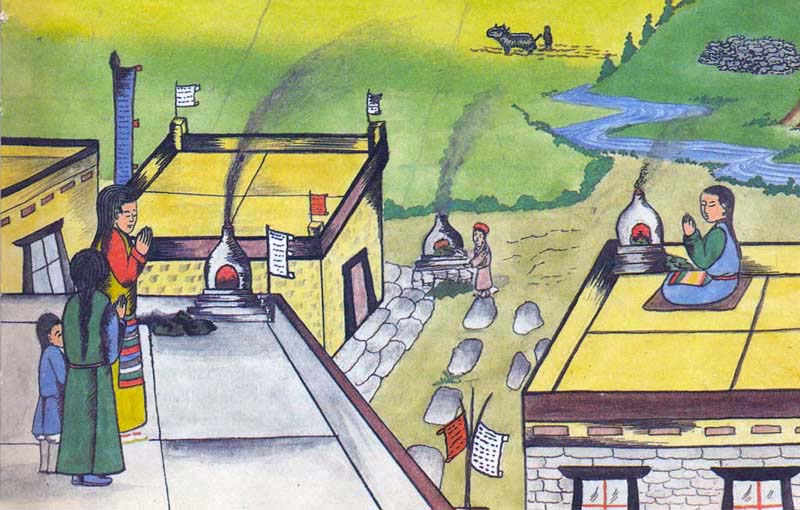As the first rays of the morning sun turned the mountains pink, faint wisps of smoke could be seen rising from the tiny village in the valley. It was not a large settlement. No more than nine or ten stone and brick houses clustered together on the hillside – each with its little central courtyard and its simple Buddhist shrine. At first light, Lhamo aged nine and her little brother, Dorjee, of six would throw back their yak-skin rugs and follow their mother onto the flat roof of the house. There the mother lit a small fire of yak-dung and made an offering of tsampa, butter and juniper wood. Then the family would pray together. All across the valley came the sweet smell of burning juniper and the singing of prayers. Every morning began like this.
Lhamo and Dorjee’s family was not rich. They owned several strips of field around the village – some good and others bad. All day, their father worked in the fields tending his crops of barley. Spring was a busy time when he harnessed his two yaks and ploughed the field and sowed the seed. When summer came, and the weeds began to sprout, everyone, even little Dorjee, helped to pull them up. Then came autumn, and the harvest had to be safely gathered in.
Lhamo often helped her mother in the house. There was barley to roast to make tsampa, and milk to churn to make butter. In winter, when the days were short and dark her mother would take some of the wool she had bought from the nomads and weave it into beautiful carpets. Life in the village was hard and simple, but everyone was friendly. Most of the men in the village called each other ‘brother’, and Lhamo and Dorjee had about six ‘grandmothers’. Sometimes friends and relatives would arrive from a neighboring village. Then there would be feasting and merrymaking. The chang would be passed around and old tales told by the fireside. Occasionally monks would visit from the nearby monastery. They would say prayers by the family shrine and read from religious books – for few people in the village knew their letters.
Not every peasant was as lucky as the family of Lhamo and Dorjee. Most of the richest farmland in Tibet was owned by the great monasteries and the nobility. On these great estates the peasant might own a plot of land for his own use, but he also had to farm the rest of his landlord’s fields, and provide various services, such as free transport, work on roads, etc. In most cases, it would seem that the monasteries and nobles dealt justly with their peasants and helped them in times of shortage. But there must have been instances of ill treatment in such a system, and there was no one, save the Dalai Lama, perhaps hundreds of kilometers away in Lhasa, to whom the peasant could appeal for help. One of the present Dalai Lama’s great hopes was to change the landowning system to make it fairer, but events overtook him before he could carry this out.

